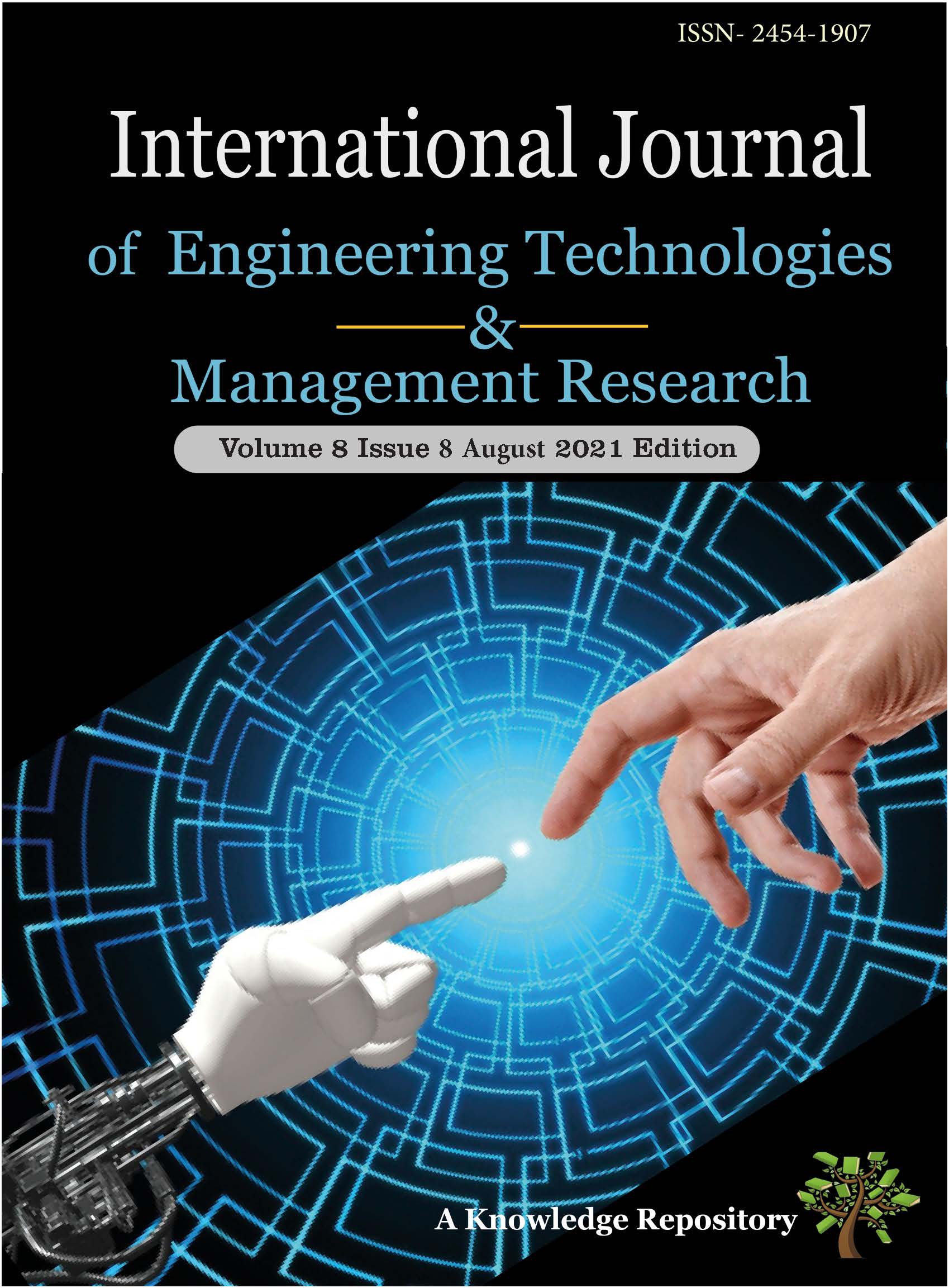EXPERIMENTAL ANALYSIS OF SOLAR DISTILLATION UNITS WITH DISTINCT OPERATING CONDITIONS
DOI:
https://doi.org/10.29121/ijetmr.v8.i8.2021.1663Keywords:
Solar Still, Desalination, Waterborne Diseases, Freshwater ScarcityAbstract
Water is an essential resource for sustaining human life on Earth. Due to the limited availability of freshwater, both rural and urban communities often face challenges, including dependence on untreated wastewater, which can lead to waterborne diseases. Groundwater, though available in certain areas, is generally present in small quantities and requires proper treatment before domestic use. With the growing demand for fresh water across agricultural, industrial, and domestic sectors, there is an urgent need for effective and sustainable water purification methods. In this study, experimental investigations were conducted on a solar distillation unit designed with sloped corners, under varying conditions during April 2019. Both conventional and modified solar stills were fabricated and tested to assess their performance. The systems were operated daily from 09:00 to 17:00 over three consecutive days. The average efficiency of each design was determined at different operational stages, and notable variations in performance were observed. The results provide insights into how design modifications can enhance freshwater production efficiency in solar still systems, offering a cost-effective solution for water scarcity issues in rural and urban regions.
Downloads
References
Abdullah, A. S., et al. (2021). Experimental Investigation of a New Design of Drum Solar Still with Reflectors Under Different Conditions. Case Studies in Thermal Engineering, 24, 100850. https://doi.org/10.1016/j.csite.2021.100850 DOI: https://doi.org/10.1016/j.csite.2021.100850
Bhargva, M., & Yadav, A. (2021). Factors Affecting the Performance of a Solar Still and Productivity Enhancement Methods: A review. Environmental Science and Pollution Research. https://doi.org/10.1007/s11356-021-15983-z DOI: https://doi.org/10.1007/s11356-021-15983-z
Chaichan, M. T., & Kazem, H. A. (2015). Water Solar Distiller Productivity Enhancement Using Concentrating Solar Water Heater and Phase Change Material (PCM). Case Studies in Thermal Engineering, 5, 151–159. https://doi.org/10.1016/j.csite.2015.03.009 DOI: https://doi.org/10.1016/j.csite.2015.03.009
Deshmukh, H. S., & Thombre, S. B. (2017). Solar Distillation with Single Basin Solar Still Using Sensible Heat Storage Materials. Desalination, 410, 91–98. https://doi.org/10.1016/j.desal.2017.01.030 DOI: https://doi.org/10.1016/j.desal.2017.01.030
Hassan, H., et al. (2020). Energy, Exergy, Environmental, and Economic Analysis of Natural and Forced Cooling of Solar Still with Porous Media. Environmental Science and Pollution Research. https://doi.org/10.1007/s11356-020-09995-4 DOI: https://doi.org/10.1007/s11356-020-09995-4
Kabeel, A. E., & El-Agouz, S. A. (2011). Review of Researches and Developments on Solar Stills. Desalination, 276, 1–12. https://doi.org/10.1016/j.desal.2011.03.042 DOI: https://doi.org/10.1016/j.desal.2011.03.042
Kaushal, A. K., Mittal, M. K., & Gangacharyulu, D. (2017). An Experimental Study of Floating Wick Basin Type Vertical Multiple Effect Diffusion Solar Still with Waste heat Recovery. Desalination, 414, 35–45. https://doi.org/10.1016/j.desal.2017.03.033 DOI: https://doi.org/10.1016/j.desal.2017.03.033
Manokar, M., et al. (2017). Different Parameter and Technique Affecting the Rate of Evaporation on Active Solar Still: A Review. Heat and Mass Transfer. Springer-Verlag GmbH Germany. DOI: https://doi.org/10.1007/s00231-017-2170-9
Manokar, M., et al. (2018). Different Parameters Affecting the Condensation Rate on an Active Solar Still: A Review. Wiley Online Library. DOI: https://doi.org/10.1002/ep.12923
NagaRaju, V., et al. (2020). Experimental Analysis of a Solar Still with and Without Phase Change Material Under Climatic Conditions of Vijayawada, India. International Journal of Scientific & Technology Research, 9(2).
Panchal, H., et al. (2018). The Requirement of Various Methods to Improve Distillate Output of Solar Still: A Review. International Journal of Ambient Energy. https://doi.org/10.1080/01430750.2018.1542630 DOI: https://doi.org/10.1080/01430750.2018.1542630
Rani, A., et al. (2021). Experimental Investigation on Thermal Behavior of Hybrid Single Slope Solar Still. Journal of Thermal Engineering, 7(3), 677–689. https://doi.org/10.18186/thermal.889191 DOI: https://doi.org/10.18186/thermal.889191
Sadaq, S. I., & Mehdi, S. N. (2018). Experimental Analysis of Solar Distillation Unit with Various Slope Angles. International Journal of Advanced Technology and Engineering Exploration, 5(44). https://doi.org/10.19101/IJATEE.2018.543014 DOI: https://doi.org/10.19101/IJATEE.2018.543014
Salem, M. R., et al. (2020). Performance Enhancement of a Solar Still Distillation Unit: A Field Investigation. Solar Energy, 202, 326–341. https://doi.org/10.1016/j.solener.2020.03.098 DOI: https://doi.org/10.1016/j.solener.2020.03.098
Downloads
Published
How to Cite
Issue
Section
License
Copyright (c) 2021 Priyanka Sharma

This work is licensed under a Creative Commons Attribution 4.0 International License.
License and Copyright Agreement
In submitting the manuscript to the journal, the authors certify that:
- They are authorized by their co-authors to enter into these arrangements.
- The work described has not been formally published before, except in the form of an abstract or as part of a published lecture, review, thesis, or overlay journal.
- That it is not under consideration for publication elsewhere.
- That its release has been approved by all the author(s) and by the responsible authorities – tacitly or explicitly – of the institutes where the work has been carried out.
- They secure the right to reproduce any material that has already been published or copyrighted elsewhere.
- They agree to the following license and copyright agreement.
Copyright
Authors who publish with International Journal of Engineering Technologies and Management Research agree to the following terms:
- Authors retain copyright and grant the journal right of first publication with the work simultaneously licensed under a Creative Commons Attribution License (CC BY-SA 4.0) that allows others to share the work with an acknowledgment of the work's authorship and initial publication in this journal.
- Authors can enter into separate, additional contractual arrangements for the non-exclusive distribution of the journal's published version of the work (e.g., post it to an institutional repository or edit it in a book), with an acknowledgment of its initial publication in this journal.
- Authors are permitted and encouraged to post their work online (e.g., in institutional repositories or on their website) before and during the submission process, as it can lead to productive exchanges, as well as earlier and greater citation of published work.
For More info, please visit CopyRight Section





















